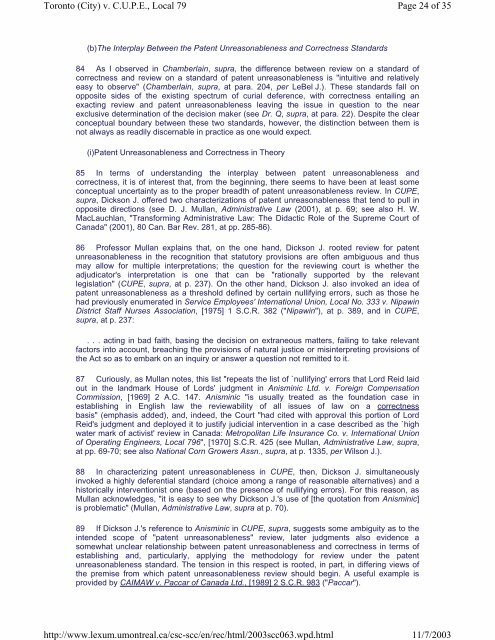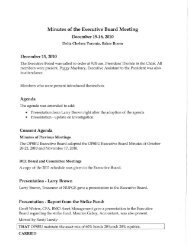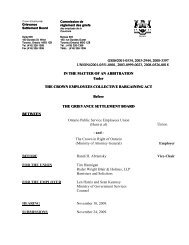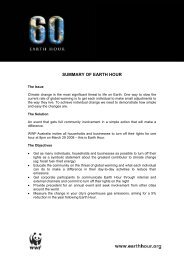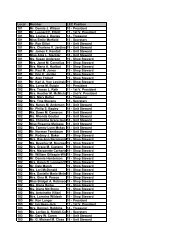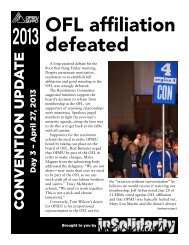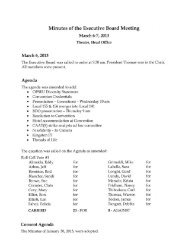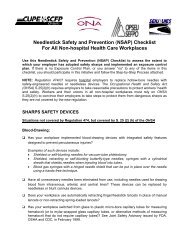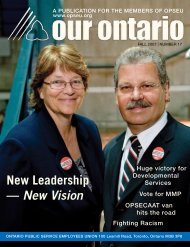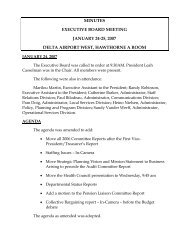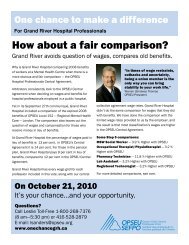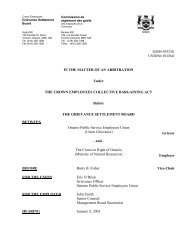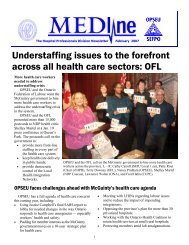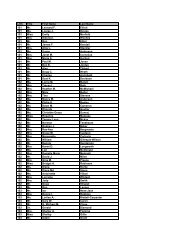C.U.P.E., Local 79 v. Toronto (City) .pdf - OPSEU
C.U.P.E., Local 79 v. Toronto (City) .pdf - OPSEU
C.U.P.E., Local 79 v. Toronto (City) .pdf - OPSEU
Create successful ePaper yourself
Turn your PDF publications into a flip-book with our unique Google optimized e-Paper software.
<strong>Toronto</strong> (<strong>City</strong>) v. C.U.P.E., <strong>Local</strong> <strong>79</strong><br />
http://www.lexum.umontreal.ca/csc-scc/en/rec/html/2003scc063.wpd.html<br />
Page 24 of 35<br />
11/7/2003<br />
(b)The Interplay Between the Patent Unreasonableness and Correctness Standards<br />
84 As I observed in Chamberlain, supra, the difference between review on a standard of<br />
correctness and review on a standard of patent unreasonableness is "intuitive and relatively<br />
easy to observe" (Chamberlain, supra, at para. 204, per LeBel J.). These standards fall on<br />
opposite sides of the existing spectrum of curial deference, with correctness entailing an<br />
exacting review and patent unreasonableness leaving the issue in question to the near<br />
exclusive determination of the decision maker (see Dr. Q, supra, at para. 22). Despite the clear<br />
conceptual boundary between these two standards, however, the distinction between them is<br />
not always as readily discernable in practice as one would expect.<br />
(i)Patent Unreasonableness and Correctness in Theory<br />
85 In terms of understanding the interplay between patent unreasonableness and<br />
correctness, it is of interest that, from the beginning, there seems to have been at least some<br />
conceptual uncertainty as to the proper breadth of patent unreasonableness review. In CUPE,<br />
supra, Dickson J. offered two characterizations of patent unreasonableness that tend to pull in<br />
opposite directions (see D. J. Mullan, Administrative Law (2001), at p. 69; see also H. W.<br />
MacLauchlan, "Transforming Administrative Law: The Didactic Role of the Supreme Court of<br />
Canada" (2001), 80 Can. Bar Rev. 281, at pp. 285-86).<br />
86 Professor Mullan explains that, on the one hand, Dickson J. rooted review for patent<br />
unreasonableness in the recognition that statutory provisions are often ambiguous and thus<br />
may allow for multiple interpretations; the question for the reviewing court is whether the<br />
adjudicator's interpretation is one that can be "rationally supported by the relevant<br />
legislation" (CUPE, supra, at p. 237). On the other hand, Dickson J. also invoked an idea of<br />
patent unreasonableness as a threshold defined by certain nullifying errors, such as those he<br />
had previously enumerated in Service Employees' International Union, <strong>Local</strong> No. 333 v. Nipawin<br />
District Staff Nurses Association, [1975] 1 S.C.R. 382 ("Nipawin"), at p. 389, and in CUPE,<br />
supra, at p. 237:<br />
. . . acting in bad faith, basing the decision on extraneous matters, failing to take relevant<br />
factors into account, breaching the provisions of natural justice or misinterpreting provisions of<br />
the Act so as to embark on an inquiry or answer a question not remitted to it.<br />
87 Curiously, as Mullan notes, this list "repeats the list of `nullifying' errors that Lord Reid laid<br />
out in the landmark House of Lords' judgment in Anisminic Ltd. v. Foreign Compensation<br />
Commission, [1969] 2 A.C. 147. Anisminic "is usually treated as the foundation case in<br />
establishing in English law the reviewability of all issues of law on a correctness<br />
basis" (emphasis added), and, indeed, the Court "had cited with approval this portion of Lord<br />
Reid's judgment and deployed it to justify judicial intervention in a case described as the `high<br />
water mark of activist' review in Canada: Metropolitan Life Insurance Co. v. International Union<br />
of Operating Engineers, <strong>Local</strong> <strong>79</strong>6", [1970] S.C.R. 425 (see Mullan, Administrative Law, supra,<br />
at pp. 69-70; see also National Corn Growers Assn., supra, at p. 1335, per Wilson J.).<br />
88 In characterizing patent unreasonableness in CUPE, then, Dickson J. simultaneously<br />
invoked a highly deferential standard (choice among a range of reasonable alternatives) and a<br />
historically interventionist one (based on the presence of nullifying errors). For this reason, as<br />
Mullan acknowledges, "it is easy to see why Dickson J.'s use of [the quotation from Anisminic]<br />
is problematic" (Mullan, Administrative Law, supra at p. 70).<br />
89 If Dickson J.'s reference to Anisminic in CUPE, supra, suggests some ambiguity as to the<br />
intended scope of "patent unreasonableness" review, later judgments also evidence a<br />
somewhat unclear relationship between patent unreasonableness and correctness in terms of<br />
establishing and, particularly, applying the methodology for review under the patent<br />
unreasonableness standard. The tension in this respect is rooted, in part, in differing views of<br />
the premise from which patent unreasonableness review should begin. A useful example is<br />
provided by CAIMAW v. Paccar of Canada Ltd., [1989] 2 S.C.R. 983 ("Paccar").


